Jerry White
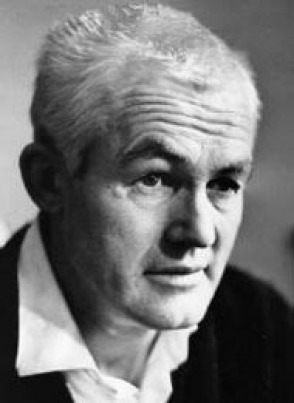
This article appears in the book London Fictions, edited by Andrew Whitehead and Jerry White – and published by Five Leaves. You can order it direct from the publishers by clicking here.
And as I gazed out on the water like a mouth, a bed, a sister, I thought how, my God, I love this city, horrible though it may be, and never ever want to leave it, come what it may send me.
This is June 1958, and the anonymous teenage narrator of Absolute Beginners pledges his loyalty to London during a night-time taxi drive along the Embankment. London was indeed ‘horrible’ in that hot tense summer. And sorely would the teenager’s loyalty be tried. For this was the moment of London’s worst race riot, the last time when Londoners witnessed, even shared in, sustained violence against strangers just because of the colour of their skin. For a moment London seemed ready to tip in the direction of America’s divided cities.
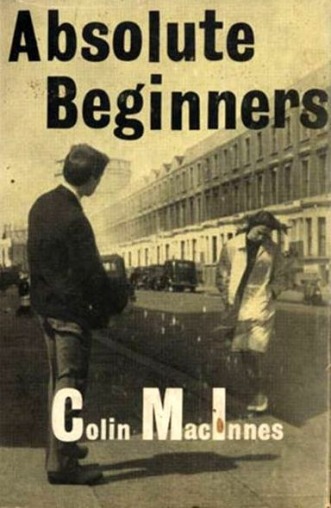 With hindsight, the Notting Hill race riot would drain the sepsis of collectively-organised white racism for a decade to come at least. But when Absolute Beginners was written and published the cuts and bruises were stinging still. The teenager might have come through the test of right-mindedness that Notting Hill had set every Londoner, but not all his acquaintances, even his friends, had done so. And fear for the future dogs every page.
With hindsight, the Notting Hill race riot would drain the sepsis of collectively-organised white racism for a decade to come at least. But when Absolute Beginners was written and published the cuts and bruises were stinging still. The teenager might have come through the test of right-mindedness that Notting Hill had set every Londoner, but not all his acquaintances, even his friends, had done so. And fear for the future dogs every page.
The question of race in London had become a defining issue for Colin MacInnes by the mid-1950s. The position of black newcomers in London encapsulated for him the problem of the outsider, the marginal, the misunderstood. This was not just some intellectual or moral proposition. For MacInnes himself was an outsider, he too was marginal, misunderstood.
It was among black Londoners that he staked his particular claim of belonging, of sympathetic identification, of personal politics, while never really able to become more than an outsider here too. In Absolute Beginners the fantasy of belonging – with his ex-girlfriend Suzette, or his mum and dad, or with Cool and the ‘Spades’ – would always just elude the teenager’s grasp. There was more of himself in Absolute Beginners, MacInnes thought, than in any other of his books.
Certainly the main area of action was close to home, at least as the crow flies. Colin MacInnes was born at The Boltons, Brompton (South Kensington), a mile and a half or so south-east of Notting Hill, in August 1914, a couple of weeks after the outbreak of the first world war. His mother, Angela Thirkell (spoken ‘Thirkle’), a popular novelist between the wars, was the grand-daughter of Sir Edward Burne-Jones, the pre-Raphaelite painter. Rudyard Kipling, whose literary achievements MacInnes rather surprisingly revered, was a great-uncle on his mother’s side. With this high-Victorian artistic heritage Angela was certainly – so Bernard Kops, the Stepney playwright and friend of MacInnes, later quipped – ‘one of the inner Thirkells’.
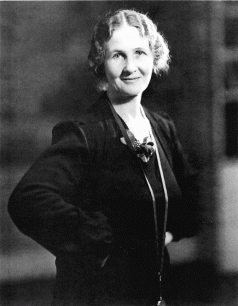
MacInnes himself though was jettisoned into some outer orbit, and it’s not hard to see why. His father, James Campbell McInnes (Colin would add the ‘a’ in his writing years) was a Scot, a well-known lieder-singer, fatally handsome, bisexual but finally preferring men to women. MacInnes would follow his father’s sexual trajectory. James and Angela divorced when the boy was just three. A year or so later Angela married again in the bewilderment of war, an Australian officer of engineers whose surname she took, and in 1919 the family emigrated to Melbourne. It didn’t work out. Angela, cut-glass South Kensington, came quickly to loathe her second husband and all about him. She sailed back to London. But she left Colin and his elder brother behind at school in Australia. When he was seventeen he followed his mother ‘home’.
MacInnes proved more than just a Londoner by accident of birth. He loved the place – just as his teenager did – and he lived all over it. He stayed at first with relatives at Pembroke Gardens, Earls Court, from 1931; in Finborough Road, Brompton, from 1936, ‘”in a sinister old slum where the ground-floor tenant was a cordial prostitute”’; in another ‘”slum in Camden Town”’ from 1938 while studying at the Euston Road School of Drawing and Painting. After war service, from 1946, he rented a floor at Regent’s Park Terrace where, while working for the BBC, he turned decisively to men for sex and to drink for oblivion. He embraced black men most hungrily of all. From the mid-1950s, as befitted his commitment to bohemia, he lived out of a suitcase at an indeterminable list of one-room addresses in Soho, Spitalfields, Pimlico, Marylebone, and just ‘nfa’ – no fixed abode. And from anywhere and everywhere he would ‘go on marathon walks through the streets of London.’
It’s no surprise then that London figures boldly in MacInnes’s fiction and in his journalism. Indeed he wrote the text for an especially fine instance of a genre that has become particularly London’s own, an intimate visual travelogue where the illustrator (Gustave Doré, Joseph Pennell, Evelyn Hofer, John Allin) plays equal, sometimes dominant, partner to the Londonist (Blanchard Jerrold, Justin McCarthy, VS Pritchett, Arnold Wesker). MacInnes’s London, city of any dream (1962) is one of the most successful, accompanied (it is that way round, I think) by the grainy colour photographs of Erwin Fieger. But MacInnes is rightly remembered most of all for his great London trilogy: City of Spades (1957), Absolute Beginners (1959), Mr Love and Justice (1960). Their canonic status was recognised when they were republished collectively as Visions of London, with an introduction by Francis Wyndham, in 1969.
Of the three, City of Spades is most evidently MacInnes’s exploration of the lives of black newcomers in London. He then sought to move on, and it’s clear that he had very different intentions in Absolute Beginners. The ‘teenager’ phenomenon had struck him forcibly from around 1956. In the pages of Twentieth Century and Encounter in particular, MacInnes was one of the first weighty journalists to take teenagers seriously – their idols, their music, their fashions, above all their spending power and new-won independence as job opportunities for the young opened up in the post-war economy as never before. In the 1950s, London was still leading the charge in the teenage revolution. Tommy Steele (‘The Pied Piper of Bermondsey’ as MacInnes, a respectful and enthusiastic admirer, called him) was in the van.
The independent world of the new teenager was the ostensible theme of Absolute Beginners. It is independence from all the baggage of the old adult war-worn world – financial, political, cultural, spiritual – and MacInnes wholeheartedly applauds it. His identification with the teenage ‘thing’ is, he would have us believe, entire. Embarrassingly so at times, especially when he invents for the teenager a hip lingo of his own to distinguish ‘the teenage ball’ from the world of ‘the tax-payers’, the ‘elderly sordids’, even the ‘short-pant sperms and chicklets’ who were merely ‘teenagers in bud’. Despite the linguistic innovations, this proves to be a teenager who left school at fifteen but can’t bear to put a ‘whom’ out of place. Whatever he did, MacInnes could never quite leave the inner Thirkells behind him.
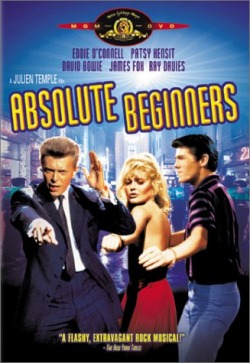
But if a celebration of the 1950s teenager is the primary objective of Absolute Beginners, race is always close to the surface and in the final quarter of the book takes over completely. Race will prove the test by which teenagers, and indeed the adult world, will be judged and some of both will be found lacking. By the end we know there are good teenagers and bad. In Absolute Beginners the Teddy Boys are as bad as they get.
As good as they get, though, is the teenager himself, a fantasy MacInnes as he would like to have been, freed from The Boltons legacy. The teenager is nearly nineteen, and so approaching his last teenage year. He works as a photographer, a prescient classless icon especially of the decade to come. He is freelance, working for himself a necessary component in MacInnes’s vision of teenage independence. And because business is hand-to-mouth he is entwined in the scrounge-flush cucle which MacInnes himself knew well. As he can’t be too fussy about where the next fiver comes from, the teenager will photograph anything, and anyone doing anything, as long as it’s for cash or an uncrossed cheque. Fashion, portraiture and pornographic poses are all grist to his Rolleiflex. His camera and his Vespa – a gift from a South American diplomat whose manly contortions he captures on film – are his only possessions of value. Like his creator, the teenager can live from a suitcase, even if strapped at the back of his scooter.
This is 1958, so the teenager is a Blitz Baby, born in an air raid or so his mother tells him. And the fractures of war – just as for MacInnes in an earlier conflict – have left baneful wounds. The teenager’s mother is too good-looking and well-endowed for her own good. She dotes on Cypriots and ‘Malts’ with hot-blooded appetites, and cavalierly cuckolds the teenager’s meek dad in his own home. His dad he loves, his mum he hates – and there’s much of the real Colin here too. He has a step-brother, Vernon or Vern – the teenager calls him Jules – who is the specky fruit of one of their mother’s flings. But the teenager and Vern don’t get on and their mutual antipathy sways always on the edge of a full-out scrap. When the teenager goes home to use the darkroom he keeps there, it’s really to keep an eye on his lonely ailing father – whose main preoccupation is collecting materials for a history of Pimlico which inevitably he’ll never finish. One knows the feeling.
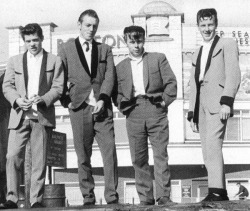
The teenager tries to keep an eye on Suzette too. She is his former girlfriend, a shop-girl with a model’s looks, moulded from her rich-mix Scotch-English-Gibraltarian-Jewish heritage. Suzette has abandoned the teenager for black men – she is ‘a Spade-lover’, ‘Spade-crazy’. Even so, Suzette ends up marrying Henley, a well-heeled fashion-designer, for his money. Henley is pallid and unequivocally gay so this will be a platonic union, and it all falls apart before the novel is over.
So, too, for different reasons as we shall see, does the teenager’s friendship with Wiz or the Wizard, wise and calculating and cold-hearted beyond his teenage years. He is the teenager’s ‘blood-brother’, but there’s bad blood here, for Wiz has a hair-trigger temper to go with his ‘razor-edge face’ – ‘”give my hate to little Suze”’ is one parting-shot to the teenager. Wiz is a wheeler-dealer, a fixer or broker, who brings buyers and sellers together in the murky metropolitan sub-economy. Pursuing the commission-agent’s course to a logical conclusion Wiz ends up a ponce, a figure of some significance in MacInnes’s London iconography. Frankie Love in his next novel would be just such an ‘other man’.
Suzette and Wiz are fellow teenagers. So is Mr Cool, a mixed-race London-born fellow lodger of the teenager’s. So is the Hoplite, outrageously queer. And so is ghastly Ed the Ted, who grunts in savage cockney – no whoms here – which has MacInnes following in great-uncle Ruddy’s footsteps. Ed is representative of the larger Ted community which will batten like carrion on the troubles in Notting Hill.
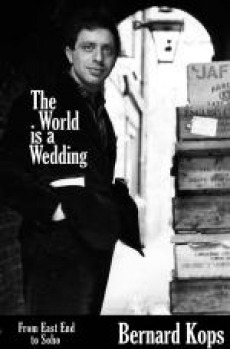 Yet although this is a teenage novel, adults get something more than a look-in. Most are either sadly beaten down or shiftily on the make. The acceptable face of adulthood is provided by Mannie and Miriam Katz. Mannie is a writer (like his original, Bernard Kops) and it is the Katzes’ warm-hearted intellectually-inquiring Jewishness that MacInnes celebrates here. Though he loves London, the teenager tells us, if all the Jews were to pack up for Israel or America then he’d leave too. He even claims (like Suzette) to have some Jewish blood himself – at least, ‘I know I’m circumcised’. Absolute Beginners, we might note here, is dedicated to Alfred Maron who was MacInnes’s Jewish landlord in Hanbury Street, Spitalfields, around the time of writing and publishing the book.
Yet although this is a teenage novel, adults get something more than a look-in. Most are either sadly beaten down or shiftily on the make. The acceptable face of adulthood is provided by Mannie and Miriam Katz. Mannie is a writer (like his original, Bernard Kops) and it is the Katzes’ warm-hearted intellectually-inquiring Jewishness that MacInnes celebrates here. Though he loves London, the teenager tells us, if all the Jews were to pack up for Israel or America then he’d leave too. He even claims (like Suzette) to have some Jewish blood himself – at least, ‘I know I’m circumcised’. Absolute Beginners, we might note here, is dedicated to Alfred Maron who was MacInnes’s Jewish landlord in Hanbury Street, Spitalfields, around the time of writing and publishing the book.
The Katzes live in the Borough, not the East End, and inner south London figures as one among several significant locations in the novel. They occupy ‘a fine old reconditioned derelict’, probably in one of the Georgian terraces lining the Borough Road. Ed the Ted, who hails like the teenager from Pimlico, has also ‘emigrated’ south of the river, ‘down to Bermondsey, to join a gang’, and it’s right that south London east and west of the Elephant was true Teddy Boy territory at the time MacInnes wrote. Smarter London gets a look in – Belgravia, for instance, where the teenager does a photo-shoot, a part of ‘picturesque Great Britain’ with ‘the flower-boxes, and the awnings over doors, and the front walls painted different shades of cream.’ So does the News-of-the-World London of Soho basement jazz and jive clubs. And so does picture-book London – the teenager has a nocturnal paddle in the Serpentine, disturbs a furtive couple in the Hyde Park bushes, samples with his father the riverside delights down to Cookham, and indulges himself in tax-rides along the Embankment at night, as we’ve seen. It’s delightful to note how such a journey could be inspirational and life-affirming even in 1958.
There are then two London districts with overriding significance. The teenager has come out of Pimlico. That’s where his mum and dad and Vern remain and where the teenager returns from time to time. By 1958 Pimlico had long been an equivocal declassed district. It had never fulfilled its South-Belgravian aspirations. By the time MacInnes first discovered it (in the 1930s) and lived there (in the 1940s) it had lost caste for two generations. It was seedy, shabby-genteel at best, outright slummy at worst, with a transient marginal population that lived on secondhand dealing, the proceeds of petty theft, and the sex trade, liveliest towards Victoria station. The teenager’s mum is not quite a Pimlico whore, but nearly. She runs a sort of boarding-house for Mediterranean men with perma-stubble and offers sexual services on the side – for kicks as much as cash it seems. Dad, resigned to his lot as an essentially kept man who is kept in the dark, is far from a ponce, but his presence makes the house respectable. And although his ‘ancestral home’ is firmly along flyblown Pimlico lines, the teenager shows us that Pimlico itself is changing, and for the better. ‘Down by the river’ are ‘the big new high blocks of glass-built flats’ at Churchill Gardens, a happy instance of postwar municipal housing, ‘like an X-ray of a stack of buildings with their skins peeled off’. Nearby is a ‘kiddipark of Disneyland items erected by the borough council’ for ‘the juveniles’. And up in Victoria there is the Empire air-terminal, in the process of extension as MacInnes was writing, where airport coaches began the journey to exotic locations.
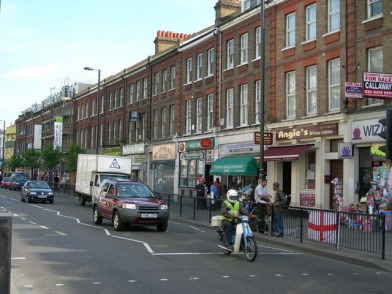
This kind of modern world, though, had not yet reached the teenager’s present home district, ‘my manor in the area of W.10 and 11’, North Kensington and Notting Hill. His part of this large area the teenager calls Napoli. The name marks it out as at once lawless in the context of metropolitan authority but living to its own rules. Napoli has ‘got left behind by the Welfare era and the Property-owning whatsit’ and is ‘nothing more than a stagnating slum. It’s dying, this bit of London, and that’s the most important thing to remember about what goes on there.’
Now topography here is not helped by MacInnes’s inability, though a seasoned traveller, to tell east from west. But what he describes as Napoli is North Kensington and Notting Hill west of Ladbroke Grove. And at the heart of it lies Notting Dale – its boundaries indeterminate on the ground – in the western part of this district off ‘long, lean’ Latimer Road. Out of it, close to Latimer Road tube and running east ‘like horrible tits dangling from a lean old sow’, range ‘what I think must really be the sinisterest highways in our city, well, just listen to their names’: Blechynden Street, Silchester Road, Walmer Road, Bramley Road and Testerton Street, and numerous others he doesn’t trouble to list. Here the houses are ‘old Victorian lower-middle tumble-down’. They ‘live on like shells’ and ‘there’s only one thing to do with them’, which is ‘to pull them down till not a one’s left standing up.’ Yet nearby, on the edge of Napoli, to the south and east near Ladbroke Grove, a different story is just beginning to be told. It’s another aspect of change in modern London but not one the teenager likes because here ‘are one or two sections that are positively posh: not fashionable, mind you, but quite graded’, even though, just ‘cheek by thing’, ‘you’re back in the slum area again’.
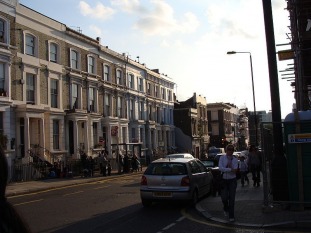
It’s in the slum Notting Dale Napoli that the teenager has his room in a house with others who would not be living there ‘if you could live anywhere else’. Yet, not quite. It is ‘so cheap’ and naturally draws the very poor. But the great attraction for the teenager and his fellow lodgers is that ‘you’re free there!’ His fellow lodgers are consequently from almost every metropolitan out-group known to the 1950s reading public, and some perhaps not known at all: Hoplite the homosexual; Big Jill, the lesbian ponce; Mr Cool, the mixed-race Londoner who doesn’t fit in, forced to make a lonely and harsh way in the world. He has a white half-brother who doesn’t like Cool much, and likes his few white friends even less. And it’s in these tensions of race and allegiance that the teenager and the other Absolute Beginners find their toughest trial in that August and September of 1958.
There was no more fitting place for a race riot – indeed, a riot of any kind – than Notting Dale. Fifty years before it had been called by George R Sims and others London’s hell on earth. There were years then when half of all the babies born there would be dead of hunger, disease and neglect before their first birthday. Perhaps the worst slums in London had been in the Bangor Street area, cleared in the early 1950s for public housing. And nearby, at 10 Rillington Place off St Mark’s Road, John Reginald Halliday Christie had murdered seven women and an infant over a ten-year period ending in 1953. It was into this desperately poor and sordid district of London that a few hundred blacks had migrated from the late-1940s on.
They found themselves in competition with their poor white neighbours: first, for housing, and second, for sex. The housing struggle had just been made fiercer than ever by the 1957 Rent Act, which weakened the rights of tenure of longstanding working-class tenants, all of whom were white of course, in favour of high-rented furnished accommodation and owner-occupation. Peter Rachman, whose name has entered the language, sharpened his claws as a landlord in North Kensington in these years. Many of his tenants were black. And the explosive combination of black men and white women readily provoked sexual envy among white men with low self-esteem. Some said it was the efforts of outraged neighbours to punish a black man with two young white girlfriends that first set Notting Hill alight.
There had been trouble between blacks and whites in Nottingham, and isolated assaults on black men in the streets of west London through that summer of 1958. Gangs of Teddy Boys smashed up cafés used by West Indians and attacked a house in Shepherd’s Bush. In the early morning of 24 August, a Sunday, nine white youths went ‘nigger-hunting’ in a car. Aged 17 to 20, mainly from Notting Dale and the White City Estate, they were armed with a knife, chair-legs, a car starting-handle, and ‘iron bars torn from street railings’, the traditional weapon of the London tough. They assaulted five black men in separate incidents in Shepherd’s Bush and Notting Hill; three West Indians were seriously hurt. That same night there was prolonged rioting, involving whites against West Indians, in Nottingham. A week later, North Kensington went the same way.
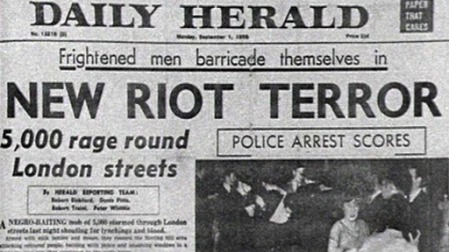 The ‘Notting Hill Riots’ began around midnight on Saturday 30 August. Crowds estimated at 400 strong attacked houses occupied by West Indians in Bramley Road, Blechynden Street, Lancaster Road and Silchester Road in the north of Notting Dale where, of all the clusters of West Indians in North Kensington, fewest lived. Windows were broken and at least one house was set on fire by a petrol bomb. Weapons included milk bottles, favoured for throwing, choppers, iron bars and knives. On Monday and Tuesday, 1 and 2 September, petrol bombs were thrown in an attack on a house in Blenheim Crescent, Notting Hill, and windows were smashed in Oxford Gardens. Thousands of people were said by police to be roaming the streets of North Kensington and there was trouble in the Harrow Road, Paddington. Violence continued in the north of Notting Dale and North Kensington and to a lesser extent in parts of Shepherd’s Bush, Paddington and Marylebone, until 5 September when the riots petered out. The streets were tense and conspicuously policed for some time after. Some 140 people, blacks among them, were arrested.
The ‘Notting Hill Riots’ began around midnight on Saturday 30 August. Crowds estimated at 400 strong attacked houses occupied by West Indians in Bramley Road, Blechynden Street, Lancaster Road and Silchester Road in the north of Notting Dale where, of all the clusters of West Indians in North Kensington, fewest lived. Windows were broken and at least one house was set on fire by a petrol bomb. Weapons included milk bottles, favoured for throwing, choppers, iron bars and knives. On Monday and Tuesday, 1 and 2 September, petrol bombs were thrown in an attack on a house in Blenheim Crescent, Notting Hill, and windows were smashed in Oxford Gardens. Thousands of people were said by police to be roaming the streets of North Kensington and there was trouble in the Harrow Road, Paddington. Violence continued in the north of Notting Dale and North Kensington and to a lesser extent in parts of Shepherd’s Bush, Paddington and Marylebone, until 5 September when the riots petered out. The streets were tense and conspicuously policed for some time after. Some 140 people, blacks among them, were arrested.
These bare bones are pretty faithfully fleshed out by MacInnes’s teenager. MacInnes followed the press reports avidly, especially those in the Manchester Guardian. Some factual incidents, like the attack on Seymour Manning who fled a mob to find sanctuary in a Latimer Road greengrocer’s, appear in the novel with little embellishment. MacInnes’s account in Absolute Beginners was singled out by the first sociological analysis of the riots a couple of years later as ‘realistic’ and ‘derived from a great deal of personal observation’. There are many telling details that stick in the mind, not least ‘the battered little delivery vans … usually dark blue, and with the back doors tied on with wire, or one door off’, in which the Teds and their allies sped from one ‘nigger-hunting’ foray to another.
But what exercises MacInnes here is how his characters will respond to the nightmare going on around them. It is a test of their very humanity. Here everyone has to take sides. There could be no mere spectators now. If you weren’t with the blacks, then you were against them.
Who can the teenager rely on? Who will take the right side? The Katzes will, of course. Outsiders by birth, they’ll stand up and fight beside the underdog. But some of the teenager’s middle-class clients and acquaintances are more difficult to engage. Observers by nature or profession they keep their distance, physically and morally, and fail the Notting Hill test. One urges the teenager ‘to get some snaps’ of the troubles for an exhibition they’d been planning together. One more turns up to film the violence for a newsreel and has an interest in seeing people hurt each other. Another urges the teenager to take care of himself. But the ex-Deb-of-Last-Year, out sight-seeing in a ‘cream vintage Bentley’ with a ‘bunch of Hooray Henries’, turns up trumps. She and the Henries see in the Teds and their supporters ‘”nothing but a lot of bloody scum”’. That’s what the teenager wants to hear. For MacInnes and the teenager, Notting Hill is a race struggle where the lowest-class slum-dwellers are the enemy’s stormtroopers. To that extent it’s a class struggle too, and The Boltons’ Kiplingesque endowment proves comfortingly right-minded in what becomes for MacInnes a battle between two Kensingtons, North and South, and between two Englands, old (before the blacks) and new.
Questions of allegiance were yet more complicated among the teenagers in that Napoli tenement house. Hoplite, for instance, is too much of an outsider to come inside with the teenager even on this most vital of all questions. He has always fancied the teenager, and to see him bruised and battle-scarred is just a turn-on, not a call to arms. Besides, he doesn’t really care for the blacks and so fails the teenager from the outset: ‘”Really, darling, I know you love them, but they’re so rough.”’ On the other hand, Hoplite is such ‘”a tit”’ that this is more forgivable eccentricity than true malevolence.
Big Jill, none more outsider than she, proves more staunch in her live-and-let-live libertarianism. She has nothing to say against the blacks, is if anything in favour, but finds more ignorance than evil in those who feed the nation’s paranoia with their anti-immigration rhetoric. Even so, she acts with the teenager, offering tea and sympathy and the free use of her phone to tell the outside world of the terrible doings in Napoli. Cool, of course, shoulders arms with the blacks, and is ‘”the only Spade in Napoli who’s thought of us”’, the white tribesmen who side with justice and against their own kind. Even better, his half-brother, forced to choose whose side he’s on, stands four-square with Cool in the street battles: their mother becomes a fire-bomb victim near Oxford Gardens as the troubles move east into Notting Hill proper.
Most of all, it is Suzette who disinterestedly and wholeheartedly commits to the blacks, just like the teenager. He stumbles across her in a basement club where ‘the boys’ are under siege from a crowd with petrol and milk bottles at the ready. Suzette has left Henley and been in Napoli a week to fight with her friends. In the mêlée she and the teenager flee to his room and make love. It’s their first time. And in their clumsy half-spoken way they move towards some kind of commitment to one another. Just what kind we’ll never know.
By this time, and in the opposite direction, the Wiz has shown the teenager his true colours. And while with Suzette the riots mark a coming together, with Wiz they provoke a terminal fracture.
They meet by accident in the Notting Dale streets and come across one of the KBW (Keep Britain White) street-meetings where fascists – Jeffrey Hamm and his British of Ex-Servicemen and Women or Victor Burgess’s Union for British Freedom – stoke the flames and the fury. It’s night, and in ‘the yellow-coloured glare’ of the street lamps the faces in the attentive crowd were ‘a kind of un-washed violet grey’. To the teenager’s horror, Wiz refuses to condemn the fanatical speaker and eventually, ‘his little body … all clenched’, he throws out a salute and cries ‘”Keep England white!”’ The teenager wreaks immediate and violent revenge, hitting Wiz in the face ‘with all my life behind it’. With one look back, he flees the crowd.

At the end of the riots, as adrenalin and fear and anger seep away, the teenager is left empty and exhausted. He feels shame and revulsion too: ‘I’d fallen right out of love with England. And even with London….’ His first thought is escape. He takes an air-terminal coach to the airport but through confusion doesn’t board a plane. And it seems likely that, in fact, he’ll stay to help build a London where black newcomers can feel truly welcome.
Which is what, in his own way, MacInnes did himself. His attachment to the hustler margins of West Indian and African migration hardened. There he found comfort in an anarchic blend of hard drinking, drugs, casual exploitative sex and hand-to-mouth freelance writing. At the end of 1965, in a move which must have given some anarchist friends a fright, he began to propagandise for Michael de Freitas (Michael X) and his English brand of Black Power. But MacInnes remained too much of an outside ever to enter a real movement, let alone something as sham and corrupt as Michael X had on offer. He drifted away, though not without appearing as a character witness for the Mangrove Nine in 1970. A year or so later and he would begin to loosen his London ties and establish a home in the house of a woman friend at Hythe on the Kent coast. He died there, of cancer of the oesophagus, in April 1976, aged 61.
What sort of London and what sort of Londoner would MacInnes have found in Napoli now?
Well, it’s been all change, and mostly for the better. Change for the worse has been in the road system. The Westway bisects North Kensington east-west above Lancaster Road. And the West Cross Route now cordons off the western boundary of Notting Dale. It has also obliterated the Notting Dale part of ‘long, lean’ Latimer Road, so that the street down which Seymour Manning fled for his life is no more. That in itself would be no bad thing but the flyovers to east and north remain monstrous beyond belief despite the forty years or thereabouts we’ve had to get over them (so to speak).
The streets that MacInnes wanted pulled down have all gone, or very nearly. Only their names survive, sometimes euphemistically. So Testerton Street is now Testerton Walk, which sounds a very different prospect altogether. It has been absorbed into the Lancaster West estate, brutalist brown-brick high-density low-rise, built in the 1970s, with raised walkways that mimic in dwarf form the flyovers nearby. There is a gaunt tower block in the middle. Henry Dickens Court to the south, brand new when MacInnes wrote, its blocks named cosily after Henry’s father’s characters (Copperfield, Barkiss, Marley, Carton), has worn astonishingly well. If Lancaster West looks presentable (which it does), Henry Dickens Court is spick and span, even manicured. This is middle-aged public housing for the botox generation, and it looks good to know.
A careful scrutiny will still reveal some small remnants of MacInnes’s Notting Dale. In Bramley Road, at the St Ann’s Road end and opposite the junction with Whitchurch Road, a scabrous terrace still (May 2008) survives of half-a-dozen double- and single-fronted tenement houses. If the makeshift torn curtains are anything to go by they’re as Notting Daly inside as out. This is still firebomb territory, but it’s difficult to imagine Molotov cocktails any more in Oxford Gardens, prim and sedately owner-occupied to the north. And Cambridge Gardens, more Notting Hilly in its overweight stucco mansions, has been rescued from generations of multi-occupation by a local housing trust that has converted them into flats. From an open drawing-room window an elderly woman waved to me as I passed. She had no milk bottle in her hand – nowadays this is a friendly area. Ladbroke Grove, pretty much the eastward boundary of the riot area, is bustling and raucous, as it probably has been now for a hundred years or so.
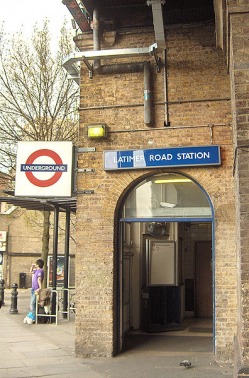
With this difference, of course, and that’s the complexion of the Londoner. Notting Dale is no longer merely the resort of the rough cockney, the wayward provincial and the boys from the Windies. They’ve all been greatly leavened by people from every country – and, one imagines, almost every class formation – under the sun. Of all the changes, without presuming to speak for someone who can’t now speak for himself, this would perhaps have surprised MacInnes most. And satisfied him most, too.
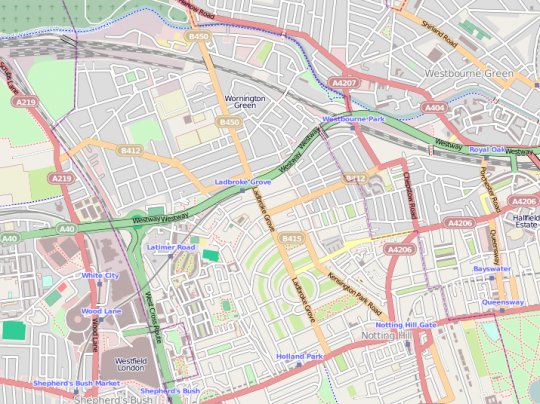
Jerry White is Visiting Professor in History at Birkbeck College, London. His publications include London in the Nineteenth Century: ‘A Human Awful Wonder of God’ (2007) and London in the Twentieth Century: A City and its People (2001), for which Jerry won the Wolfson History Prize.
References
Colin MacInnes: City of Spades, 1957; Absolute Beginners, 1959; Mr Love and Justice, 1960; England, Half English, 1961; London, city of any dream, 1962
Tony Gould: Inside Outsider. The Life and Times of Colin MacInnes, 1983
George R Sims: Off the Track in London, 1911
Ruth Glass: Newcomers. The West Indians in London, 1960
Pearl Jephcott: A Troubled Area. Notes on Notting Hill, 1964
All rights to the text remain with the author.
